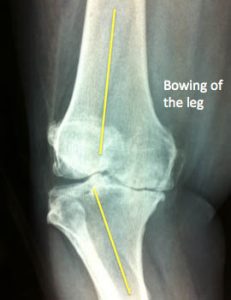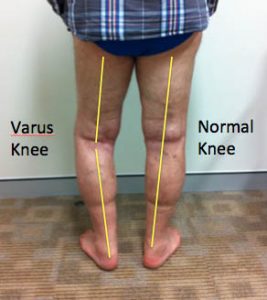Arthritis is inflammation of one or more joints with damage to the joint lining cartilage. There are many different types of arthritis but osteoarthritis is the most common in Australia.
Once it has started knee arthritis cannot be stopped but its progress can be slowed. Arthritis involves the breakdown of cartilage which normally protects the joint and allows it to move smoothly. Cartilage, along with the meniscus, absorbs shock when pressure is placed on the joint. Walking places quite low loads on the cartilage but running and jumping place very high stresses on the articular cartilage. High stresses will lead to more rapid breakdown if damage is already present. Loss of the normal amount of cartilage eventually allows the knee bones rub together, causing pain, swelling and stiffness.
There is a strong genetic component to knee arthritis which ‘runs in families’. If you damage your joint or break a bone which sets crooked you are quite likely to get arthritis from the increased load on the articular cartilage. An infection which ‘eats’ the cartilage will also lead to arthritis. Loss of part of the knee joint’s usual protective mechanisms will also lead to arthritis. This is why damaging your meniscus or ligament often leads to long term problems in the knee.
Arthritis is a cyclical disease. The joint inflammation can go away for a while after the cause goes away or is treated. Sometimes it does not and then it is referred to as chronic arthritis.
Our joints are also not designed to handle excessive loads. That is why obesity leads to joint damage. This is one of the most common causes of arthritis in the knee and the symptoms are often relieved by losing weight.
Arthritis causes joint pain, swelling, stiffness, and limited movement. As the knee arthritis gets worse you tend to get pain at rest as well as with activity. Eventually the knee pain starts to wake you at night time and interfere with all your day to day activities.
Examination
An arthritic knee will usually be:
- Swollen (fluid on the knee)
- Warm, red and tender
- Stiff (limited movement, usually a loss of bending)



Some types of arthritis may cause joint deformity. In the knee you often start to look like a bow legged cowboy.
The goal of treatment is to reduce your knee pain, improve your knee function, and prevent further joint damage. The underlying cause cannot be cured but many people live with minimal or moderate symptoms for many years. Eventually the arthritis worsens and then you can consider having a total knee replacement.
The most effective way to reduce the symptoms of knee arthritis is to lose weight. As little as 5% body weight loss has been shown to reduce pain levels and improve function.
Exercise can help relieve stiffness, reduce pain and fatigue; and improve muscle and bone strength.
Exercise programs should include:
- Low-impact aerobic activity
- Range of motion exercises to reduce stiffness
- Strength training for muscle tone
- Ice
- Splints can reduce the load on a particular part of the joint (A valgus unloading brace can help people with medial compartment arthritis of the knee before it gets to the bone on bone stage)
- Water based exercise (hydrotherapy)
- Paracetamol or Panadol Osteo
- Nonsteroidal anti-inflammatory drugs (NSAIDs) reduce inflammation and can help with arthritis pain. These have potential side effects which you should discuss with me, your GP or chemist.
- Stronger pain killers such as Panadeine Forte, Tramadol or Endone.
- Corticosteroids (“steroids”) help reduce inflammation. These are injected into the knee to reduce inflammation directly.
Surgery may be needed if other treatments have not worked. This may vary from arthroscopy (to do a spring cleaning of the joint) to total knee joint replacement (which removes the diseased tissues altogether).
Stem Cells
The idea of stem cells being able to give you a new joint is a very sexy and attractive concept. The reality is that they probably act as a powerful anti-inflammatory in the joint. They might slow down the progress of the arthritis but so far have not been shown to regenerate new tissue. We are researching this area very carefully right now so new developments might take place very soon.